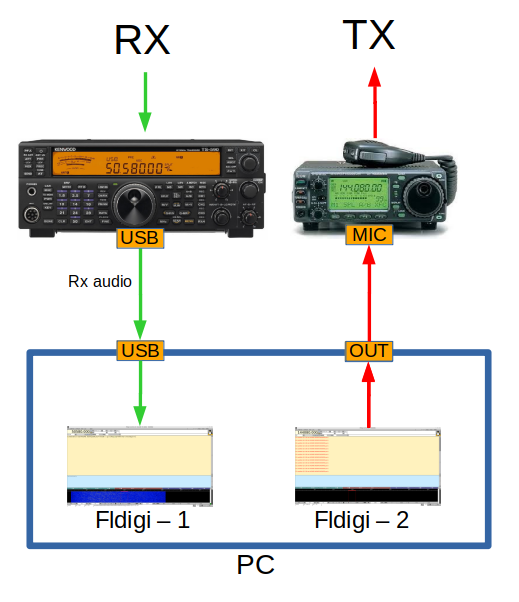IK0WRB
Using Qatar Oscar 100
|
Qatar Oscar 100 is a radio amateur satellite, or actually radio amateur equipment put aboard the TV satellite Es'Hailsat 2, in geostationary orbit at around 25.5 degrees east.
This is the first geostationary radio amateur satellite ever. It has two transponders, one for narrow band transmissions and the other dedicated to wide band, useful for DATV (Digital Amateur TV). The following pictures, got from some web sites, show the satellite coverage and the allocation of frequencies. As you can see, the input is 2400-2400.5 and 2401.5-2409.5 MHz, while the output is 10489.5-10490 and 10491-10499 MHz. 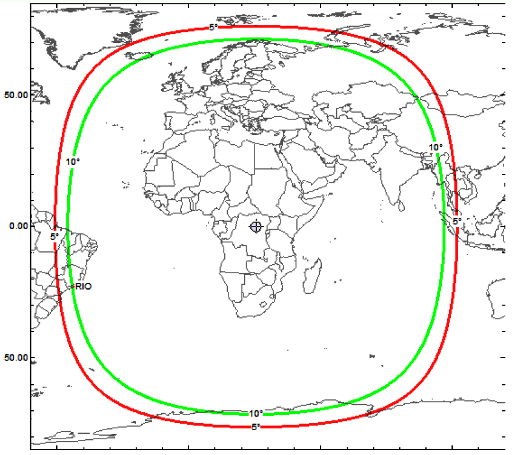 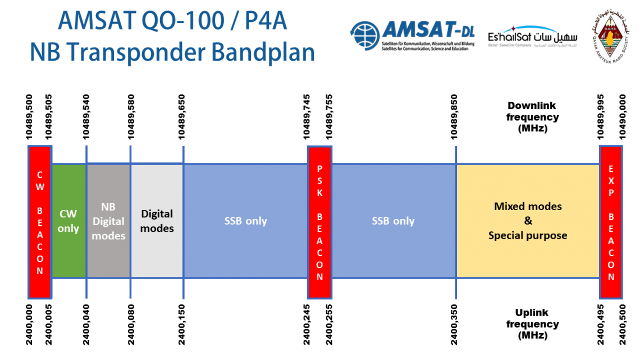  ReceivingStarting February 5, 2021, I can receive the narrow band QSOs from QO-100, because I installed a few devices on the dish I have been using for TV for several decades. The dish was aiming at 13 East, with a second LNB at 19.2 East and in order to aim also at 25.5 East, I moved it to point the central LNB at 19.2 East and the right one at 13 East. This way the third feed to the left can easily reach the 25.5 East of QO-100. In the following picture you see the method I used.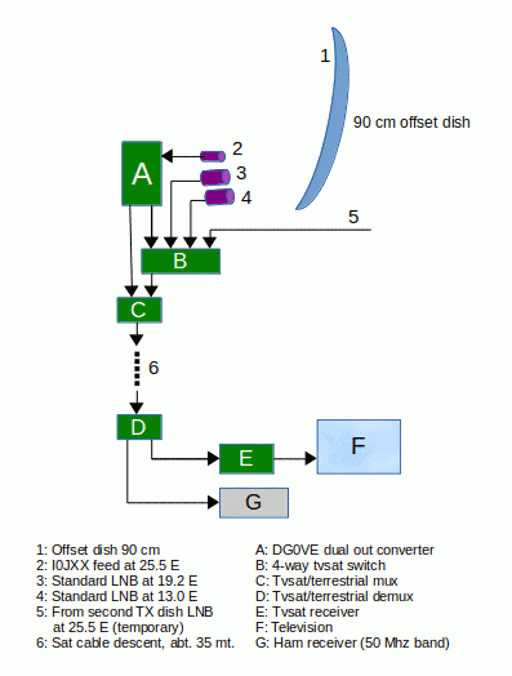 The following video shows the first signals received while working at the dish on the roof. When switching on, the converter is not stable at all. This picture shows the lower CW beacon on the WSJT-X waterfall. The interval among horizontal lines is 15 seconds. 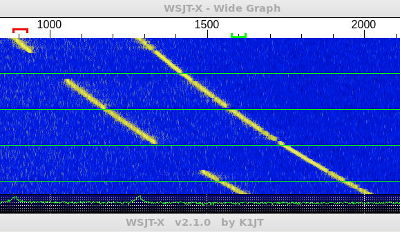 However, after about 8 minutes, it becomes quite stable. 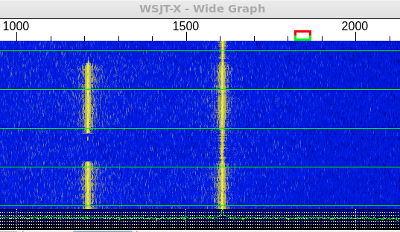 I find this is almost perfect, but there is a product missing on the market today, which would enable to receive both DATV and narrow band signals with ease. I am thinking about a modified tv sat LNB, with the following features:
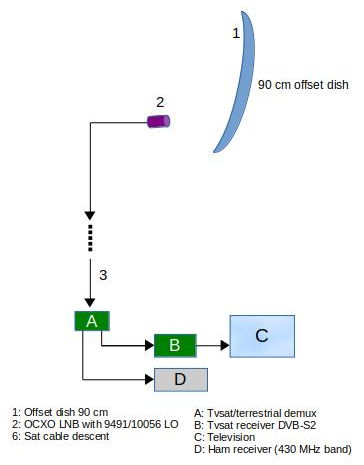 The cable from the LNB would go into a standard and cheap sat/earth demux. The sat part would go into a standard DVB-S2 receiver/decoder and the terrestrial part into a 70 cm band receiver. At this point using the sat decoder we could:
By the way if you are interested only to the narrow band signals, you can use the most popular method: a standard tv LNB set in V pol. with a 13 V DC bias and a receiver at 739.5-740 MHz (SDR, SSB scanner, etc.). TransmittingStarting February 22, 2021 I can also transmit to the satellite. The following picture shows the transmitting schema.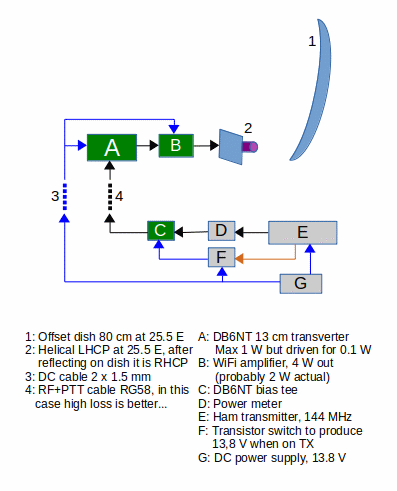 At the moment I am using an Icom IC-706MkIIg as transmitting rig, which cannot transmit at the low levels required by the transverter input. So I did set the transverter gain to the minimum and I used RG58 cable, quite lossy at 144 MHz (on purpose!). This way my descent has about 6 dB of loss and I can transmit up to about 20 W at 144 MHz, which will translate to about 5 W at the transverter input. This would give me 1 W at 2.4 GHz, but wait! There is the cheap WiFi amplifier after, and it accepts only up to about 100 mW! So actually I drive the transverter at 2 W (0.5 W on the roof) and the RG58 attenuation is really part of the game. Why I did not use simply an attenuator? Well, I had to lay out a new cable in a busy Rome building, so a cable which is thin, light, cheap and had the right attenuation was just perfect! To regulate the power levels, lacking wattmeters for the 13 cm band, I looked at the specs, then I measured the current at tx with no signal and with signal. I already made several contacts, in SSB, CW and FT8. I also listened to transmissions in RTTY and SSTV. Really beautiful! During the first days, I opened sometimes the web sdr site at websdr.is0grb.it:8901, to see the whole band at a glance and quickly tune my receiver to the signals. However, now I am not using it anymore, relying only on the manual sweep of the band. 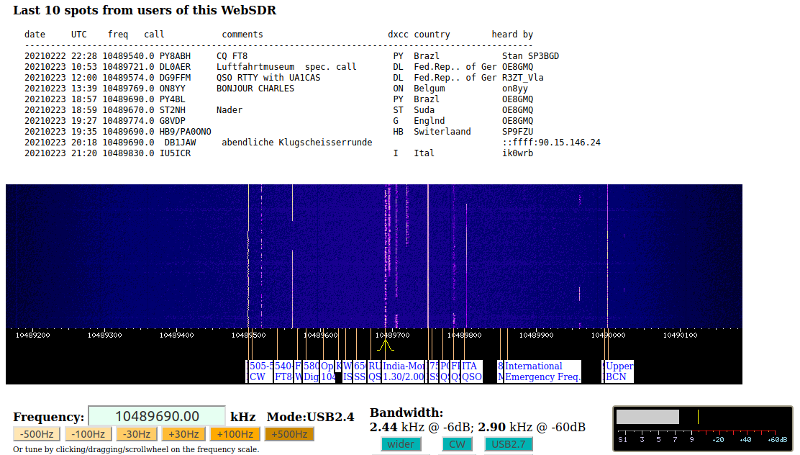 Since this web sdr is GPS controlled, it is useful to check the drift of your transmitter. It turned out that the DB6NT transverter is very stable indeed! This is my transmitting dish. I used RG-213 from the amplifier to the helix, because I had it available and here RG-58 is too lossy, 1 meter would lose about 1 dB! For now it is ok this way, but perhaps I will replace the RG-213 with a shorter cable with RF-240. 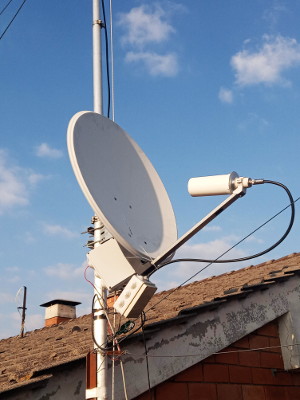 Digital modes on the satellite
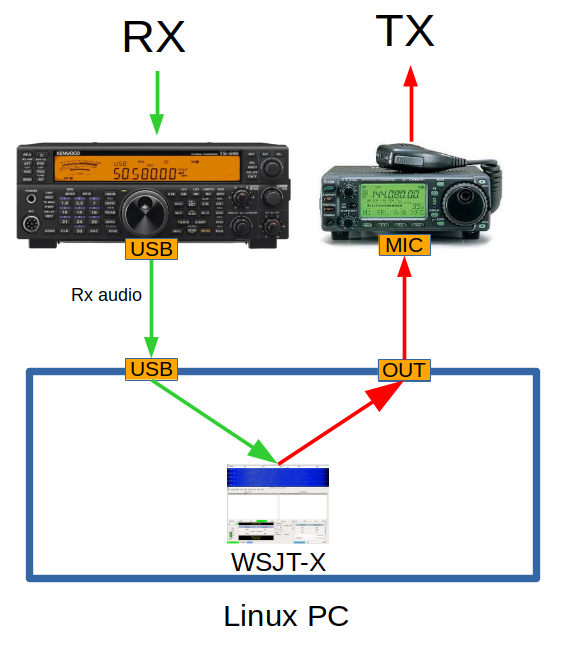 September 2022I did not use QO-100 for many months, then, when I came back from the 2022 summer holidays, I wanted to try it again, but I found that the DG0VE downlink converter was broken. I don't know why this happened, perhaps it was due to a lightning or something similar.So I had to change my setup and, since DG0VE is sk, I bought a TCXO controlled LNB. This simplified the setup on the roof, but now the signal I have to receive is in the 739.5 - 740 MHz range. Happily enough, I had an SDR receiver in my drawer, so I connected it to my PC. Using the GQRX program under Linux, I tried receiving all SSB transmissions from the satellite and make QSO in this mode. I could also use CW, even if the tuning on GQRX is not that easy. For digital modes I was planning to install a 739 MHz to 50 MHz converter, so to use my HF radio as a receiver again, for all modes. Unfortunately on October 11 I received a phone call from Germany, telling me that the downconverter, by the Italian firm Elad, is temporarily out of production, for the lack of electronic components. Thus I switched my mind from hardware to software. On the same day I installed on Linux the Jack package and after some try I succeded in routing the output of the program I am using now, CubicSDR, to the input of WSJT-X. At the same time the output of WSJT-X goes to the sound card, where it goes to the mic input of my IC-706MkIIg. So now I am back to FT8 on QO-100! (and without spending a cent). The only problem is the lack of stability, so QSOs are possible only at times. The LNB is TCXO controlled, so the source of thermal instabilities can only be the HackRF One receiver and/or the PC itself. I am planning now to add a TCXO external oscillator to the receiver, which can be only beneficial to the overall stability of the receiving chain. Here it is my latest setup. 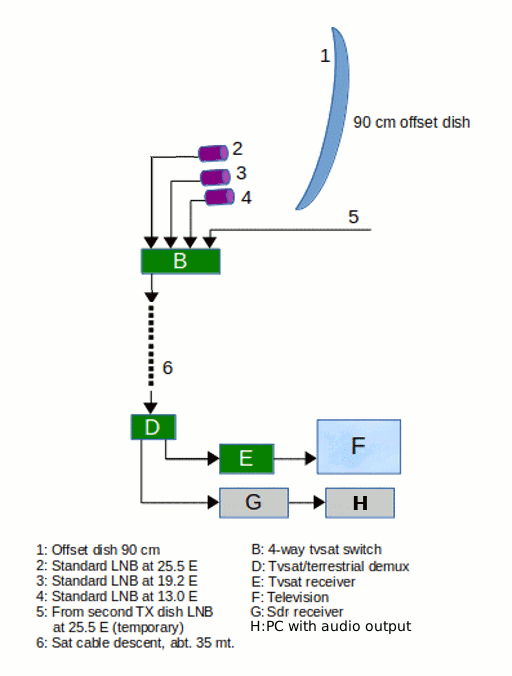 November 2022I added a 10 MHz external OCXO to the HackRF SDR receiver, but this did not change things too much. Apparently it is the LNB that it not as stable as announced, although it contains a TXCO. QSOs are possible in all analog and digital modes, with the notable exception of FT8, workable only at times.For now, I will stick to this configuration. Meanwhile I am studying possible cheap GPS modules able to produce a rock stable 10 MHz signal, transforming it to 25 MHz (it exists a chip for this!) and feeding it to a modified LNB. It is a pity no one sells a GPS-driven LNB! December 2022The cheap 10 MHz OCXO broke, but this was not a big problem, since the SDR stability was almost the same. I worked many stations in SSB and FT4 and even in FT8, when the external temperature was not moving fast.I noticed that some stations updload their satellite QSOs to Lotw the wrong way. They do not specifiy that it is a sat QSO in the adif file! As an example, I show here the row of a satellite QSO, that way it should be (data is not real): <QSO_DATE:8>20221228 <TIME_ON:6>093600 <BAND:4>13cm <MODE:3>SSB <CALL:5>TF1ZX <PROP_MODE:3>SAT <SAT_NAME:6>QO-100 <BAND_RX:3>3cm <EOR>It is important that at least the "<PROP_MODE:3>SAT" is present, otherwise LoTW will think this is a tropo 13cm QSO and it will never match the corresponding QSO. March 2024Finally, I found that the OCXO controlled LNB is not stable at all, it is like a standard LNB sold at higher price...After summer 2023 I found that someone had pulled the cables near my transmitting dish, on the building terrace. This broke one SMA connector on the transverter. This stopped my sat activity for about six months, because I was totally deceived by this cruel action. In March 2024 I tried to repair the transverter and set it all back as before. First new QSOs were on the evening of March 15, 2024, but I noticed that for some reason my uplink signal is much weaker than before. Since one BNC plug is really aged, when I have time I will try changing this, but it could also be the transverter not working as before... May 2024For the last 2/3 months I was only able to do FT8/FT4 QSOs, because my output power was really too weak to do SSB. This way I lost the possibility to contact some interesting DXpeditions. As a side consideration, I discovered that you can work QO-100 even with milliwatts. The rx sensitivity up there is simply astonishing.On day 12 I bypassed the tx amplifier to check if it was working (it worked), then I replaced the DB6NT transverter with a DX Patrol upconverter I had bought meanwhile, as a cheaper replacement. This module is made in Portugal and worked at the first try. So now I am back with some power on the satellite, thus I will do also SSB QSOs. Reports for FT8/FT4 went from -10/-18 to +5/+10 decibels, driving the converter at the lower possibile level I can use. I am happy that everything is working well again! I will try to better repair the transverter module, because it is a pity not to use it, possibly in a holidays QTH or the like. November 2024During this month I made twochanges to my setup. First of all I added a TCXO clock module to the HackRF SDR receiver and this proved to be a good move. Stability of reception was now much better, so I discovered that most of the drift came from the SDR receiver. However there is still some drifts, caused by the "Bullseyes" LNB. But a standard LNB is much worse that this one, so I should switch to an OCXO o GPS controlled LNB.I am also experimenting with a circuit I built, using a GPS module and a DDS, plus a microcontroller, to digitally control the frequency of the LNB local oscillator. More to come. I also changed the driver for the TX, because the old Icom IC-706 MkIIg showed a lot of defects, it even shut down randomly... I bought an Icom IC-7100, that will also be useful for possible mobile operations. It is connected to the PC via an USB cable, so I also gained a cleaner audio both for TX and RX and the CAT. It is interesting the buying it at a local ham store instead than online spared me 30% of the price! Always check in local stores, before going online. See you on the satellite!
Vinicio, IK0WRB |
